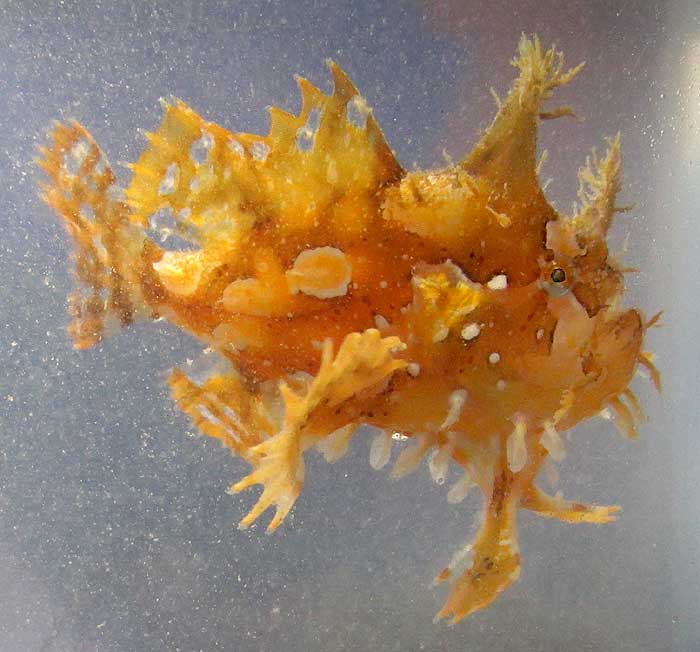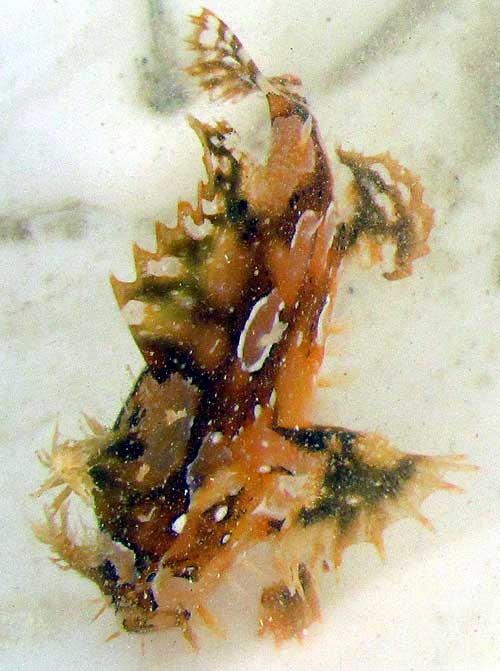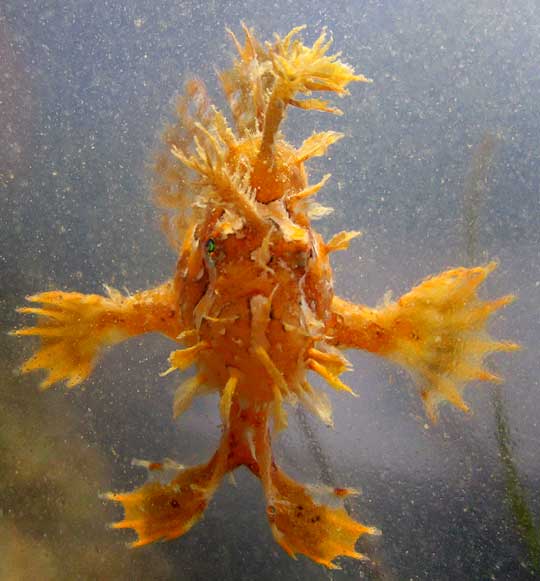Excerpts from Jim Conrad's
Naturalist Newsletter

from the February 22, 2015 Newsletter issued from Río Lagartos, on the Yucatan Peninsula's northern coast (~N21.60°, ~W88.16°), Yucatán state, MÉXICO
SARGASSUM FISH
A little after dawn the tide was so low that Rayo and I could wade across what normally is a deeply submerged field of Shoalgrass, and we were seeing amazing things. When Rayo let out a whoop and used his cap to scoop up something from the water, I knew he'd spotted something good, because he liked that cap. Below, you can see what he caught after it was released into the cut-off bottom of a plastic jug:

Back at the restaurant/ecotour office the elegant little 4cm fish (1.5in) was transferred into an aquarium, Rayo illuminated it from above with his cellphone light, and I got the picture at the top of this page. You can see that by then the fish's patterns had changed a lot. When the fish turned around to face me, it was hard to figure out what was what, as seen below:
 .
.
Before long the whole crew was angling for a closer look, everyone guessing at its name but no one really knowing. They couldn't believe they'd spent their whole lives here fishing and leading tours but hadn't known that such an awesome being lived in the Shoalgrass right in front of town. My biologist friend Willie went onto the Internet looking for pictures, and before long he'd IDed it, announcing to all that it was a Sargassum Fish, HISTRIO HISTRIO.
The Sargassum Fish occurs in tropical and subtropical waters nearly worldwide, at depths of down to 10m (33 ft), especially where drifting seaweed accumulates, such as Sargasso alga, which we have a lot of here, two species of it. One species is profiled at www.backyardnature.net/yucatan/sargasso.htm.
The Sargassum fish grows to 20cm long (7.9 in), so ours is a young one. It's described as a voracious ambush-predator, and a cannibal that eats smaller members of its own species. It stalks its prey amid tangles of aquatic plants, dangling its nose ornament to attract small fish, shrimp, and other invertebrates to within gulping distance. It can expand its mouth to many times its original size in a fraction of a second, drawing prey in via suction, and can swallow prey larger than itself. When something chases it, it can jump from the water onto the top of floating vegetation and wait until its enemy goes away. Rayo thinks that that's why he saw the fish and could catch him -- the fish had jumped from the water onto a tangle of Shoalgrass.
One behavior we often see in the aquarium is that the fish will sidle up to a vertically standing aquatic plant and with his side fin, the pectoral, pull the plant's stem closer to its body. He may do this with plants on both sides. The effect is to hide the fish better among the vegetation, and the technique is very effective. Several times we've decided that he must have disappeared someplace, only later to find him swimming around as always.